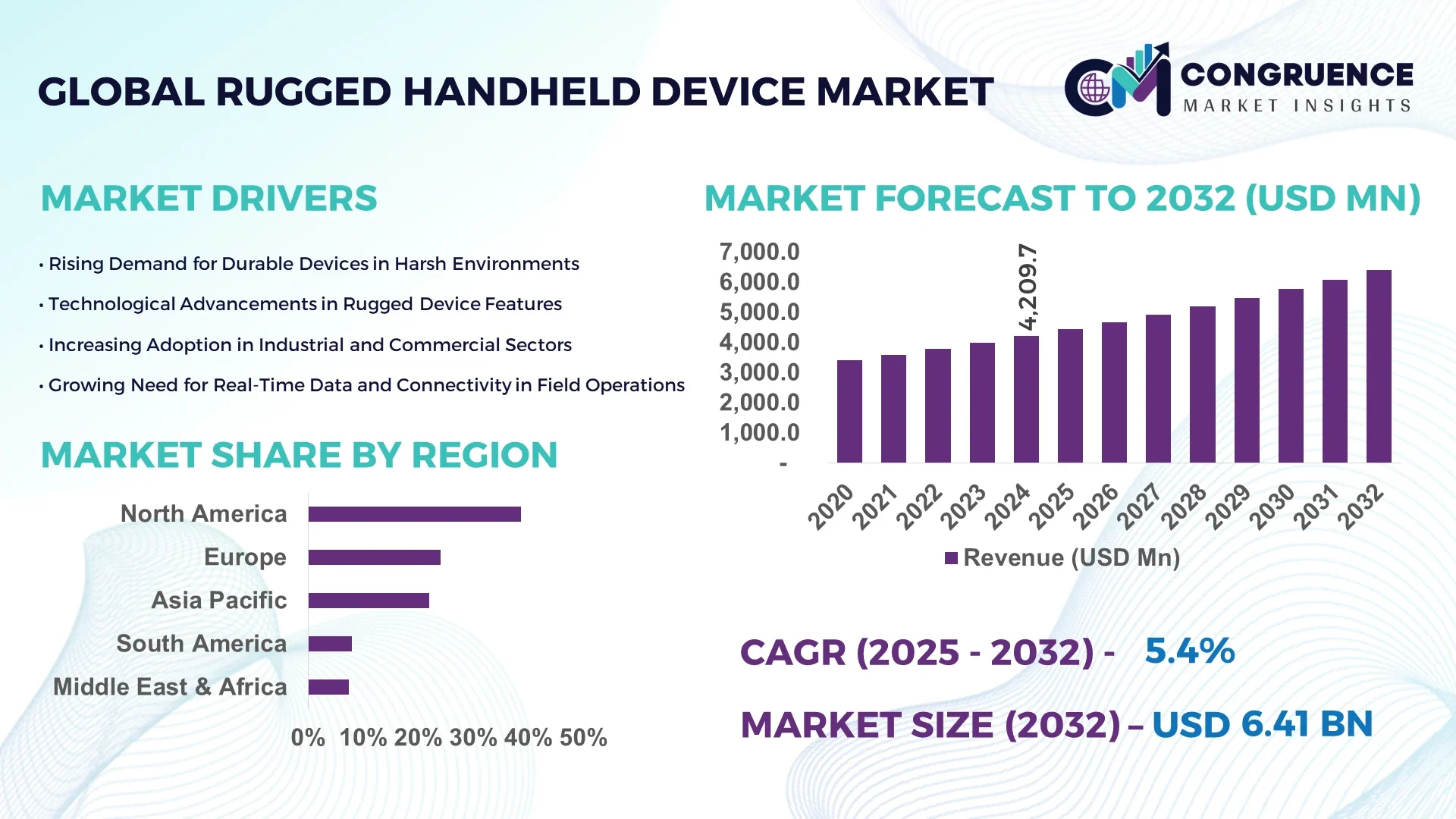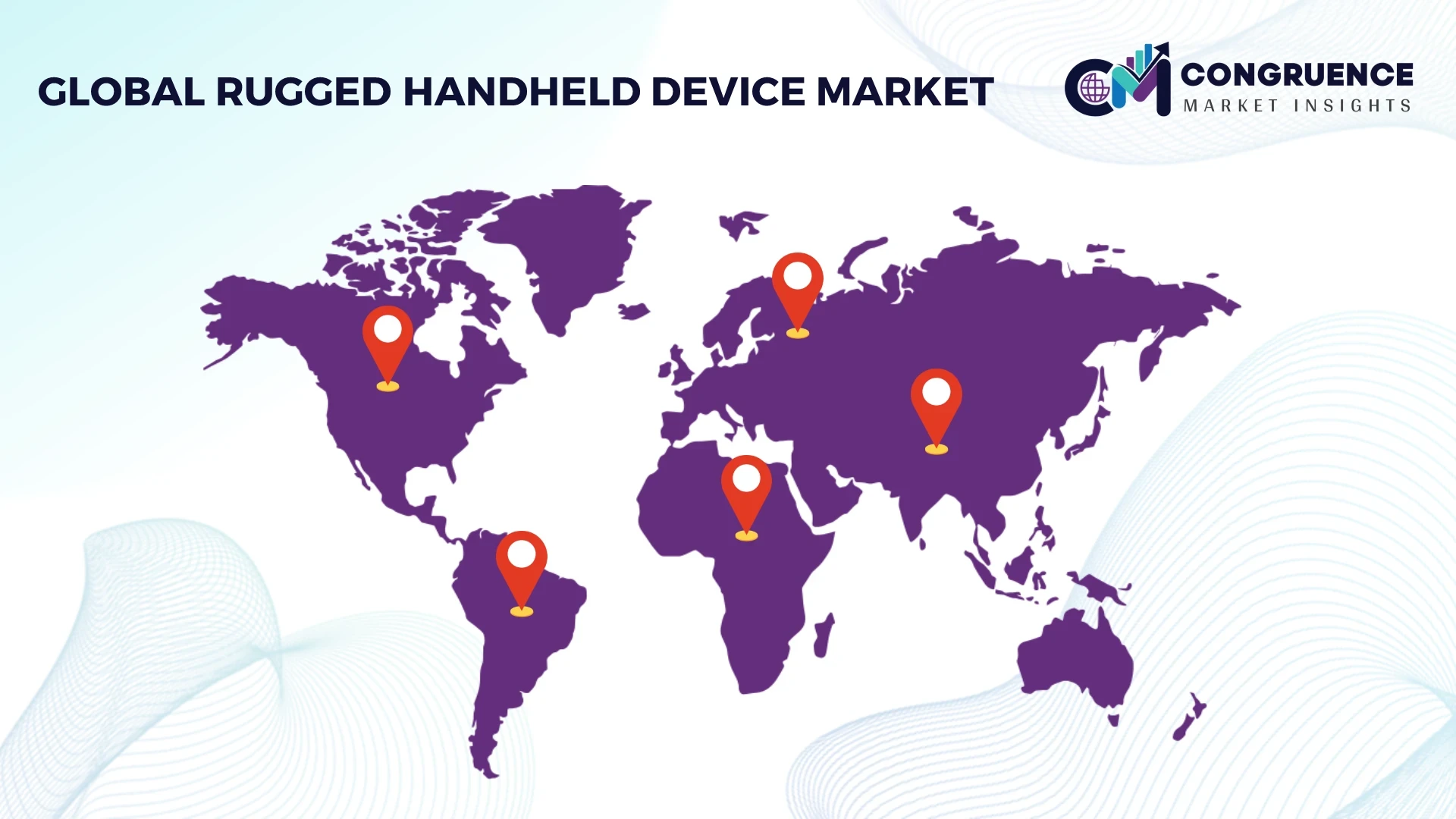Zebra Technologies Corporation, Panasonic Corporation, Honeywell International Inc., Datalogic S.p.A., Getac Technology Corporation, Juniper Systems Inc., Handheld Group AB, Trimble Inc., Bluebird Inc., CipherLab Co., Ltd.
Reports
The Global Rugged Handheld Device Market was valued at USD 4,209.7 Million in 2024 and is anticipated to reach a value of USD 6,411.7 Million by 2032 expanding at a CAGR of 5.4% between 2025 and 2032.

The rugged handheld device market is driven by a rising need for field-ready mobile solutions capable of withstanding harsh environments, such as construction sites, industrial zones, and defense operations. These devices feature robust enclosures, reinforced screens, and extended battery life, offering high performance in extreme temperatures, dust, water, and impact conditions. Sectors like logistics and warehousing are increasingly adopting rugged handhelds for real-time tracking, asset management, and barcode scanning. The growing shift towards digital transformation across utilities, energy, and public safety sectors is further reinforcing the need for ruggedized smart devices that maintain connectivity and functionality regardless of environmental adversity. Integration with advanced wireless technologies, GPS, and sensors is pushing innovation in the global rugged handheld device market.
Artificial Intelligence (AI) is revolutionizing the rugged handheld device market by enabling smart automation, advanced predictive analytics, and edge computing capabilities. AI-powered rugged devices are now capable of processing vast amounts of real-time data on-site, reducing dependence on cloud infrastructure. In logistics and warehousing, AI enhances inventory accuracy and delivery optimization by integrating with RFID and GPS. Military-grade rugged devices are leveraging AI for real-time threat detection, facial recognition, and battlefield communication. AI also plays a critical role in predictive maintenance by identifying signs of device failure before downtime occurs, enhancing operational efficiency.
In industrial environments, AI embedded within rugged tablets or PDAs is improving workflow efficiency by automating routine inspections, capturing anomalies, and alerting technicians. These intelligent rugged devices can also assist field workers by offering AI-based voice support and real-time decision-making tools, even in offline modes. As companies focus more on workforce mobility and digital transformation, the integration of AI into rugged handheld devices is becoming a market differentiator, improving safety, performance, and productivity.
"In February 2024, Zebra Technologies integrated Edge AI into its rugged tablets, enabling offline machine learning capabilities to assist field workers in remote industrial environments."
With the rapid expansion of mobile field workforces in logistics, utilities, and construction, the demand for rugged handheld devices has surged. These sectors require equipment that can endure drops, vibration, water exposure, and extreme temperature variations. For instance, rugged smartphones used in oil and gas sectors are required to comply with ATEX and IECEx standards, boosting their adoption. Logistics firms using rugged PDAs for barcode scanning report increased inventory accuracy and faster delivery turnarounds. Such devices support both front-line efficiency and back-end integration, driving growth across multiple industries.
Despite the long-term benefits, rugged handheld devices often come with higher initial investment compared to consumer-grade alternatives. Small and medium enterprises (SMEs) find it difficult to justify these upfront costs, especially when replacing multiple units. Additionally, repair and maintenance for specialized components like reinforced touchscreens and waterproof sealing can be costly. In sectors where budget constraints are critical, such financial burdens hinder widespread adoption. Moreover, rugged devices require regular calibration and servicing to maintain compliance with safety standards, adding to the total cost of ownership.
As smart city initiatives gain momentum globally, the demand for connected, durable mobile devices for on-field operations has intensified. Rugged handhelds are playing a key role in traffic management, public safety inspections, infrastructure maintenance, and utility management. Governments and private infrastructure developers are investing in ruggedized technology for outdoor data collection, sensor monitoring, and emergency communication. These devices are being deployed in waste management systems, street lighting networks, and water utility systems, offering reliable performance in rain, dust, and high-humidity conditions. The expansion of smart infrastructure opens vast growth potential for the rugged handheld device market.
Many rugged handheld devices struggle with seamless integration into rapidly evolving enterprise software ecosystems. Compatibility issues with ERP systems, cloud platforms, and proprietary mobile apps can disrupt operations. Additionally, some rugged operating systems lag behind mainstream devices in supporting updates and security patches, creating gaps in data protection. Field workers often experience delays in workflows due to these integration limitations. As industries digitize rapidly, rugged device manufacturers are challenged to balance hardware resilience with software adaptability and cross-platform support, which is essential to remain competitive.
The rugged handheld device market is witnessing transformative trends shaped by advancements in hardware, connectivity, and user-centric features. There is growing demand for 5G-enabled rugged smartphones and tablets, offering ultra-low latency and high-speed connectivity, especially for remote industrial and defense applications. Manufacturers are incorporating biometric authentication like fingerprint and iris recognition for added device security in sensitive operations. The adoption of Android OS over traditional Windows systems is becoming more prevalent due to its developer-friendly ecosystem and app compatibility.
Battery innovations are also a key trend, with hot-swappable and high-capacity batteries ensuring longer usage without interruption, especially in field services. Edge computing is being embedded within rugged handhelds, enabling on-device processing for time-critical tasks. Multi-mode communication support, including LTE, Wi-Fi 6, and satellite connectivity, is becoming a standard offering. Furthermore, the design is becoming more ergonomic, allowing one-handed use and improved readability in direct sunlight. Industries such as mining, agriculture, and first response services are actively embracing these trends to streamline operations and boost field productivity.
The Rugged Handheld Device Market is segmented by type, application, and end-user, each contributing uniquely to the market's growth. Understanding these segments provides insights into the market dynamics and helps stakeholders make informed decisions.
Semi-Rugged Devices: Semi-rugged devices are designed to withstand moderate environmental conditions, making them suitable for industries like retail and healthcare. These devices offer a balance between durability and cost-effectiveness, featuring reinforced casings and resistance to dust and minor drops. Their adaptability and lower price point make them a popular choice for businesses seeking durability without the premium cost of fully rugged devices.
Fully Rugged Devices: Fully rugged devices are built to operate in harsh environments, including extreme temperatures, moisture, and heavy vibrations. They are commonly used in industries such as construction, manufacturing, and military operations. These devices often comply with military standards for durability and are equipped with features like sunlight-readable displays and extended battery life, ensuring reliability in demanding conditions.
Ultra-Rugged Devices: Ultra-rugged devices represent the pinnacle of durability, designed for the most extreme conditions. They are ideal for use in industries like oil and gas, mining, and emergency services. These devices can withstand severe impacts, submersion in water, and exposure to hazardous materials. Their robust construction ensures uninterrupted performance in the most challenging environments.
Logistics: In the logistics sector, rugged handheld devices are essential for real-time tracking, inventory management, and route optimization. These devices enhance operational efficiency by providing accurate data collection and communication capabilities, even in challenging environments like warehouses and distribution centers.
Manufacturing: Manufacturing industries utilize rugged handheld devices for tasks such as equipment monitoring, quality control, and workflow management. These devices help in minimizing downtime and improving productivity by providing workers with reliable tools that function seamlessly in industrial settings.
Construction: Construction sites demand devices that can endure dust, moisture, and rough handling. Rugged handheld devices in this sector are used for project management, safety inspections, and communication among teams, ensuring that projects stay on schedule and within budget.
Military & Defense: In military and defense applications, rugged handheld devices are critical for mission planning, navigation, and secure communication. Their ability to function under extreme conditions and resist tampering makes them indispensable tools for defense personnel.
Industrial: Industrial sectors, including manufacturing and energy, rely on rugged handheld devices for monitoring operations, managing assets, and ensuring worker safety. These devices support the automation of processes and provide real-time data, contributing to increased efficiency and reduced operational costs.
Commercial: Commercial enterprises, such as retail and hospitality, use rugged handheld devices for inventory management, point-of-sale transactions, and customer service. Their durability ensures continuous operation in high-traffic environments, enhancing customer satisfaction and business performance.
Government: Government agencies employ rugged handheld devices for public safety, infrastructure maintenance, and emergency response. These devices enable field workers to access critical information, communicate effectively, and perform their duties efficiently, even in adverse conditions.
North America accounted for the largest market share at 38.6% in 2024; however, Asia Pacific is expected to register the fastest growth, expanding at a CAGR of 6.7% between 2025 and 2032.

The global rugged handheld device market is exhibiting region-specific momentum due to variations in industrial infrastructure and digital transformation initiatives. North America leads due to widespread use in defense, public safety, and logistics. Europe maintains steady demand owing to a strong focus on operational efficiency across manufacturing and transportation. Asia Pacific’s rapid industrialization, coupled with the rise of e-commerce and infrastructure projects in China, India, and Southeast Asia, is fueling accelerated growth. Meanwhile, the Middle East & Africa region is showing increasing adoption across oil & gas, mining, and government projects, although from a lower base. South America also displays positive trends, particularly in logistics and utilities, supported by the modernization of field operations.
Operational Expansion and Technological Integration Drive Demand
North America led the global rugged handheld device market in 2024, accounting for 38.6% of the market. The United States remains the key driver, with high demand from logistics, military, and emergency response teams who rely on ruggedized Android and Windows handhelds for real-time communication, asset tracking, and safety-critical operations. The growing adoption of 5G-enabled rugged devices, AI-powered data collection apps, and cloud-based fleet management tools further strengthens market growth. Canada is also contributing significantly, especially in mining and construction, where durable mobile computers support productivity under extreme conditions. The regional market is characterized by rapid upgrades to smart rugged devices, compliance with safety regulations, and the emergence of next-gen wearable rugged tech in field services.
Efficiency and Worker Safety Lead the Adoption Curve
Europe continues to be a significant market for rugged handheld devices in 2024, driven by industrial automation, digital warehousing, and growing safety mandates. Countries like Germany, France, and the UK are embracing rugged mobile solutions to optimize workflows in logistics, energy, and manufacturing. The demand for devices that withstand vibrations, dust, and water is increasing, especially for field technicians and maintenance crews. Integration with IoT platforms and remote diagnostics capabilities are also key adoption drivers. In Eastern Europe, logistics and public transportation are seeing growing demand for rugged barcode scanners and RFID readers. Additionally, European environmental and safety standards are pushing industries to replace traditional consumer-grade mobile devices with rugged alternatives that offer longer lifespans and lower total cost of ownership.
Industrial Growth and Smart Infrastructure Fuel Expansion
The Asia-Pacific region is expected to experience the fastest growth in the rugged handheld device market. In 2024, the region accounted for over 25% of the global market share. China and India are leading in adoption due to booming manufacturing sectors, expanding public infrastructure, and the rapid digitization of logistics. Japanese and South Korean companies are also leveraging ruggedized mobile computers for automation in factories and warehouse environments. The demand for IP-rated devices resistant to heat, dust, and drops is rising in industrial hubs. Government initiatives to digitize utility and transportation sectors are boosting demand for rugged devices among meter readers, transport inspectors, and maintenance personnel. Local manufacturers are increasingly entering the market with cost-effective rugged solutions, further driving regional competitiveness.
Digital Modernization in Energy and Defense Sectors Pushes Growth
The Middle East & Africa region is gradually expanding in the rugged handheld device space, with strong adoption across oil & gas, mining, and defense sectors. In 2024, the region held approximately 8% of the global market share. Countries like the UAE and Saudi Arabia are utilizing rugged handhelds for utility inspections, logistics, and field communications in remote desert operations. In Sub-Saharan Africa, mining companies are equipping workers with rugged devices for real-time coordination in harsh terrains. The need for devices with long battery life, extreme durability, and satellite communication compatibility is shaping product preferences. Government modernization initiatives in sectors like security and infrastructure are expected to further fuel demand, especially as rugged devices become integral to digital transformation in field-based operations.
The rugged handheld device market is characterized by intense competition, with numerous players striving to enhance their market presence through innovation and strategic partnerships. Key manufacturers are focusing on developing devices that offer superior durability, advanced features, and seamless connectivity to cater to the evolving needs of industries such as logistics, manufacturing, and defense.
Companies are investing in research and development to introduce rugged devices that can withstand extreme environmental conditions while providing high performance. The integration of advanced technologies like AI and IoT in rugged handheld devices is becoming a standard, enabling real-time data collection and analysis, which is crucial for decision-making processes in various sectors.
Moreover, strategic collaborations and acquisitions are prevalent in the market as companies aim to expand their product portfolios and geographical reach. The emphasis on customer-centric solutions and after-sales services is also a significant factor influencing competitive dynamics. As the demand for rugged handheld devices continues to grow, driven by the need for operational efficiency and workforce mobility, the market is expected to witness further consolidation and innovation.
Zebra Technologies Corporation
Panasonic Corporation
Honeywell International Inc.
Datalogic S.p.A.
Getac Technology Corporation
Juniper Systems Inc.
Handheld Group AB
Trimble Inc.
Bluebird Inc.
CipherLab Co., Ltd.
Technological advancements are at the forefront of the rugged handheld device market, driving the development of devices that are not only durable but also equipped with cutting-edge features. Modern rugged handheld devices are designed to operate efficiently in harsh environments, offering resistance to water, dust, and extreme temperatures, which is essential for industries like construction, logistics, and military operations.
The integration of high-resolution touchscreens that are readable in direct sunlight and operable with gloves has significantly improved user experience. Additionally, the incorporation of long-lasting batteries ensures uninterrupted operation during extended fieldwork. Connectivity options such as 5G, Wi-Fi 6, and Bluetooth 5.0 are becoming standard, facilitating real-time data transmission and communication.
Furthermore, the adoption of AI and machine learning algorithms enables predictive maintenance and efficient resource management. These technologies allow for the collection and analysis of vast amounts of data, leading to informed decision-making and enhanced operational efficiency. As industries continue to embrace digital transformation, the demand for technologically advanced rugged handheld devices is expected to rise, prompting manufacturers to focus on innovation and user-centric designs.
In April 2025, Samsung introduced the Galaxy XCover7 Pro, a rugged smartphone featuring a removable 4,350mAh battery, Snapdragon 7s Gen 3 chipset, and IP68 and MIL-STD-810H certifications, targeting frontline professionals in demanding environments.
In March 2024, Zebra Technologies launched the TC73 and TC78 rugged mobile computers, equipped with advanced scanning capabilities and 5G connectivity, aimed at enhancing productivity in field operations.
In February 2024, Panasonic unveiled the Toughbook S1, a fully rugged Android tablet with a 7-inch display, designed for industries requiring reliable performance in extreme conditions.
In January 2024, Getac Technology Corporation released the ZX10, a rugged tablet featuring a 10-inch display, Qualcomm Snapdragon 660 processor, and Android 11 OS, catering to sectors like public safety and utilities.
In December 2023, Honeywell announced the CT45XP rugged mobile computer, offering enhanced data capture, connectivity, and battery life, suitable for logistics and warehouse management applications.
The rugged handheld device market encompasses a wide range of products designed to operate reliably in harsh environments and demanding conditions. These devices are essential tools in industries such as manufacturing, logistics, construction, and public safety, where durability and performance are critical.
The market is segmented based on device type, including smartphones, tablets, and PDAs, each tailored to specific industry needs. Applications of rugged handheld devices span across inventory management, field service, asset tracking, and data collection, highlighting their versatility and importance in modern operations.
End-users of rugged handheld devices include sectors like defense, transportation, healthcare, and agriculture, each requiring specialized features to meet their unique operational challenges. Geographically, the market is analyzed across regions such as North America, Europe, Asia-Pacific, Latin America, and the Middle East & Africa, considering factors like industrial growth, technological adoption, and infrastructure development.
The report provides a comprehensive analysis of market trends, growth drivers, challenges, and opportunities, offering valuable insights for stakeholders to make informed decisions. It also examines the competitive landscape, profiling key players and their strategies to maintain and enhance their market positions.
| Report Attribute/Metric | Report Details |
|---|---|
|
Market Revenue in 2024 |
USD 4,209.7 Million |
|
Market Revenue in 2032 |
USD 6,411.7 Million |
|
CAGR (2025 - 2032) |
5.4% |
|
Base Year |
2024 |
|
Forecast Period |
2025 - 2032 |
|
Historic Period |
2020 - 2024 |
|
Segments Covered |
By Types
By Application
By End-User
|
|
Key Report Deliverable |
Revenue Forecast, Growth Trends, Market Dynamics, Segmental Overview, Regional and Country-wise Analysis, Competition Landscape |
|
Region Covered |
North America, Europe, Asia-Pacific, South America, Middle East, Africa |
|
Key Players Analyzed |
Zebra Technologies Corporation, Panasonic Corporation, Honeywell International Inc., Datalogic S.p.A., Getac Technology Corporation, Juniper Systems Inc., Handheld Group AB, Trimble Inc., Bluebird Inc., CipherLab Co., Ltd. |
|
Customization & Pricing |
Available on Request (10% Customization is Free) |
